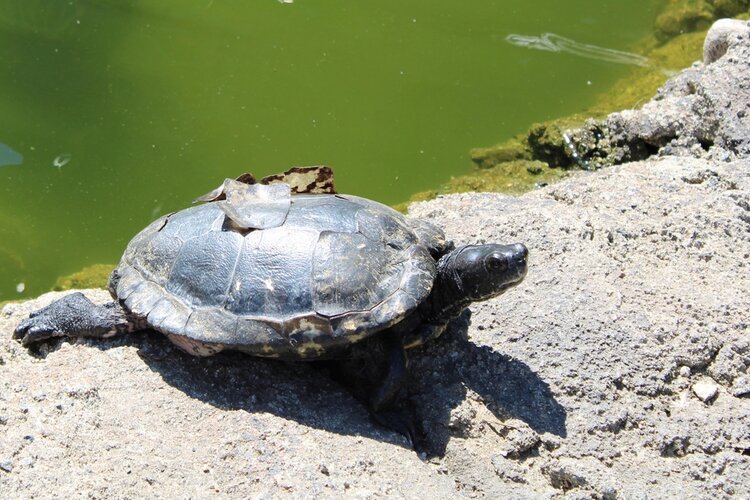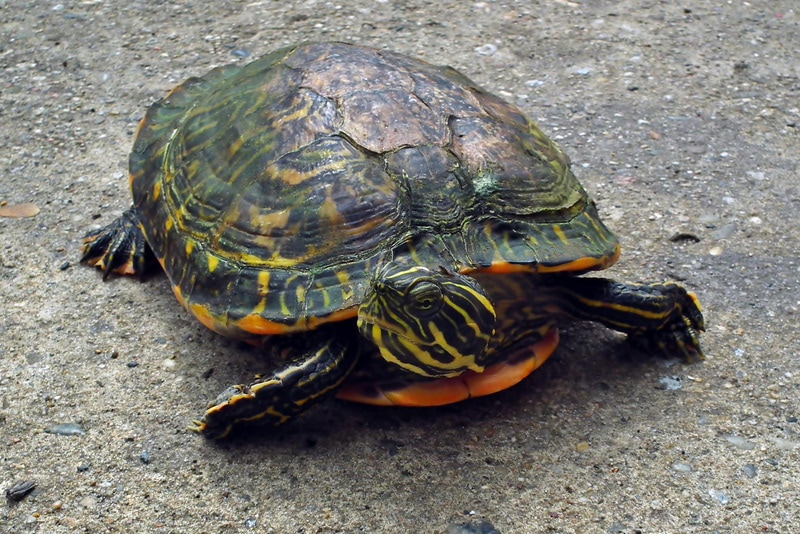
We all know that reptiles such as snakes and lizards shed their skin, but what about turtles? They are covered in a shell with only their head and legs exposed. The answer is, yes, turtles do shed.
The main purpose of turtles shedding is for growth, though there are many other reasons as well. Shedding occurs most often in young turtles since it is part of the growing process. Adult turtles will also shed but generally, it will be much less often.
 Can Turtles Shed Their Shells?
Can Turtles Shed Their Shells?
A turtle’s shell is made up of approximately 60 bones, including the backbone, ribs, and breastbone. Many species of turtle have shells that are covered in hard scutes, which protect the shell.
These scutes are overlapping pieces of keratin that protect the bones and epithelium of the shell underneath. These scutes go through a shedding process
Scute shedding generally occurs when a turtle is growing. In some species of turtles, the shedding will begin when they reach a certain age.
Some scute will be shed to ward off infection if they have been damaged, as it will help the turtle rid itself of vulnerable areas in the shell. Improper diet or living conditions can also cause scute shedding.

Do All Turtles Shed?
Not all turtles shed their shell. Some species of turtles have soft shells that do not go through the shedding process. The soft-shelled turtle’s shell is a more leather-like texture rather than hard and bony. They lack the scutes that the other species of turtles have.
If an owner of a softshell turtle were to notice anything odd with their shell that even resembled shedding, it’s best to contact a veterinarian because it is likely due to a health condition.
While not all turtle species shed, all turtles shed their skin. As the turtle ages and grows, it will shed the skin on the head, neck, and legs.
It is more difficult to notice the shedding of the skin since the shell covers most of the body and it’s usually easier to observe when the turtle is under the water.
What to Look For When a Turtle Sheds
Your pet turtle may begin basking the UVB light when a shed is approaching. You may also notice them rubbing their shells against objects in their tank or enclosure.
A slight change in the shell’s coloration may be noticeable around this time and it may look a bit more shiny than usual.
The scutes on the shell will simply shed or peel away to make way for larger ones. The individual scutes will slough off during the turtles day to day activities. Shed scutes are not thick and appear nearly translucent.
It may look tempting to assist in the shedding process by pull the peeling scute off but this is unnecessary. This is a natural process and it’s best to leave the turtle alone and allow the shed to take place naturally.
There are some ways to help your turtle have a healthy shed. Vitamins A and E are essential for shell growth, you’ll want to make sure these vitamins are included in their diet. You also need to have UVB lamps available or have a setup that gives the turtle access to natural sunlight.
You can place décor, such as rocks, within the enclosure or tank that can be of assistance when shedding. You’ll notice the turtle may rub against these objects to help loosen the scute.

Can a Turtle Shed Too Much?
Aquatic turtles naturally shed more than terrestrial turtles. If you notice your turtle is shedding its skin excessively, it can be due to a variety of reasons.
 Conclusion
Conclusion
The shedding process of turtles is unique compared to any other reptile. It is a normal, natural occurrence that is very common while the turtle grows. Terrestrial turtles will shed less than their aquatic counterparts.
Due to lack of scutes, soft-shelled turtles will not shed the shell. All turtle species will shed skin as they grow but it’s not nearly as noticeable as scute shedding.
As an owner, if you notice signs of excessive skin shedding or scute shedding, it is typically due to rapid growth as a result of overfeeding but could also be signs of more serious conditions.
Always have a veterinarian available for any health concerns and ensure you are implementing proper husbandry so your turtle can thrive and shed with ease.
Featured Image Credit: Jaclyn Vernace, Shutterstock

 Can Turtles Shed Their Shells?
Can Turtles Shed Their Shells?





